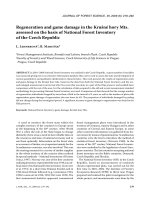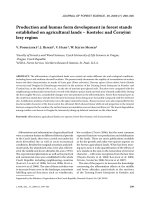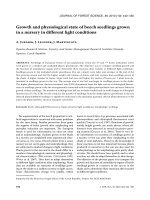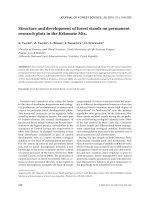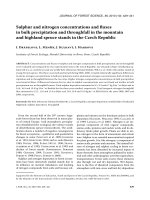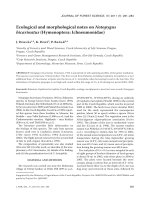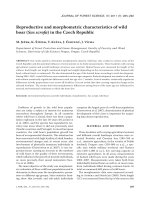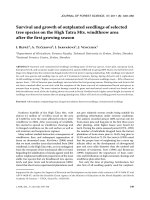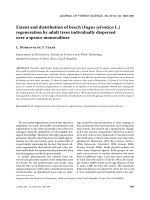Báo cáo lâm nghiệp: "Latitudinal and altitudinal variation of bud burst in western populations of sessile oak" docx
Bạn đang xem bản rút gọn của tài liệu. Xem và tải ngay bản đầy đủ của tài liệu tại đây (367.05 KB, 8 trang )
Original
article
Latitudinal
and
altitudinal
variation
of
bud
burst
in
western
populations
of
sessile
oak
(Quercus
petraea
(Matt)
Liebl)
A
Ducousso
1
JP
Guyon
A
Krémer
1
1
Laboratoire
de
génétique
et
d’amélioration
des
arbres
forestiers,
Inra,
BP
45,
33611
Cestas-Gazinet;
2
Stir
Ouest,
ONF,
BP
521,
13,
avenue
du
Général-de-Gaulle,
72017
Le
Mans,
France
(Received
20
December
1994;
accepted
26
July
1995)
Summary—
Latitudinal
and
altitudinal
variations
of
bud
burst
in
western
populations
of
sessile
oak
(Quer-
cus
petraea
(Matt)
Liebl)
are
examined.
The
phenology
of
bud
burst
in
50
populations
of
sessile
oak
has
been
studied
in
four
provenance
tests
located
in
France.
The
authors
obtained
large
variations
between
populations
and
these
variations
are
linked
to
altitude,
latitude
and
spring
frost
tolerance.
The
northern
populations
and
those
close
to
the
sea
level
are
the
latest.
These
populations
are
more
tolerant
to
the
late
spring
frost.
Due
to
the
geographical
structuration,
which
is
linked
to
adaptative
characters,
we
advise
foresters
to
use
sessile
oak
of
local
origins.
Quercus
petraea
/
phenology
/ provenance
test
/ frost
hardiness
/ genetic
differentiation
Résumé —
Structuration
altitudinale
et
latitudinale
du
débourrement
des
bourgeons
de
popu-
lations
d’Europe
de
l’Ouest
de
chêne
sessile
(Quercus
petraea
(Matt)
Liebl).
Le
comportement
du
débourrement
des
bourgeons
au
printemps
a
été étudié
dans
un
réseau
de
comparaison
de
provenances
de
chêne
sessile
sur
50
populations.
Des
variations
importantes
dans
le
comportement
phénologique
entre
les
populations
ont
été
mises
en
évidence
et
elles
ont
pu
être
reliées
à
la
latitude
et
l’altitude
ainsi
qu’à
la
tolérance
au
froid.
Les
populations
tardives
sont
nordiques
ou
d’altitude
faible.
Ces
même
populations
sont plus
résistantes
aux
gelées
printanières
tardives.
Du
fait
de
la
structuration
géogra-
phique
observée
et
de
sa
liaison
avec
des
caractères
adaptatifs,
il
est
conseillé
aux
forestiers
d’utili-
ser
des
origines
locales
pour
les
reboisements
artificiels
de
chêne
sessile.
Quercus
petraea
/ phénologie
/ test
de
provenance
/ tolérance
au
froid / différenciation
génétique
INTRODUCTION
Local
adaptation
results
when
a
population
has
evolved
through
natural
selection
in
response
to
specific
ecological
conditions.
For
outcrossing
plant
species,
such
as
tree
species,
the
efficiency
of
selection
is
reduced
by
a
high
rate
of
gene
flow
(Endler,
1977;
Loveless
and
Hamrick,
1984;
Slatkin,
1985).
However,
forest
geneticists
have
doc-
umented
genetic
differentiation
among
pop-
ulations
occupying
different
geographical
areas
with
different
markers
such
as
molec-
ular
markers
(Yeh
and
O’Malley,
1980;
El
Kassaby
and
Sziklai,
1982;
Kremer
et
al,
1991;
Kremer
and
Petit,
1993;
Müller-Starck
et
al,
1993;
Petit
et
al,
1993;
Zanetto
et
al,
1993),
physiological
characters
(Flint,
1972;
Liepe,
1993)
and
quantitative
traits
(Libby
et
al,
1969;
McGee,
1974;
Kriebel
et
al,
1976;
Jensen,
1993;
Sork
et
al,
1993).
In
this
contribution
we
will
report
on
the
geo-
graphic
variation
of
bud
burst
in
Quercus
petraea.
The
economic
and
ecological
importance
of
sessile
oak
(Q
petraea)
gives
the
species
a
high
priority
for
genetic
research.
The
National
Forest
Service
(ONF)
and
two
research
institutes
(CEMAGREF
and
INRA)
have
launched
a
program
to
evaluate
range-
wide
genetic
diversity
to
provide
a
basis
for
genetic
conservation
and
management.
Since
1989,
four
provenances
tests
have
been
established
in
France
along
a
gradient
from
west
to
east
and
more
than
100
prove-
nances
will
be
tested.
The
bud
phenology
has
been
the
sub-
ject
of
numerous
studies
in
forestry
and
arboriculture.
This
character
is
of
primary
importance
since
it
is
linked
to
frost
resis-
tance
and
avoidance
of
pests.
Furthermore,
clinal
variation
has
been
reported
in
vari-
ous
studies
(Wright,
1976).
The
present
study
gives
preliminary
results
from
these
provenance
tests
and
tries
to
determine
the
origin
of
bud
phenology
differentiation
between
populations
of
sessile
oak.
MATERIALS
AND
METHODS
Plant
material
Sessile
oak
(Q
petraea)
is
widely
distributed
in
Europe
from
north
of
Spain
to
south
of
Scandi-
navia
and
from
Ireland
to
Eastern
Europe.
It
occurs
in
the
plains
on
most
types
of
soil
from
sea
level
to
1
300
m
elevation.
Experimental
design
The
sample
of
populations
covered
most
of
the
species
range
and
contained
more
than
100
pop-
ulations.
However,
for
this
paper
only
data
from
western
populations
were
available:
from
France
(42),
Ireland
(3),
Great
Britain
(2)
and
Germany
(3).
Hundred
kilograms
of
seeds
were
collected
from
50
points
covering
25
ha
per
geographic
origin.
The
populations
were
collected
on
2
succes-
sive
years
(set
1
in
1986
and
set
2
in
1987).
The
seeds
were
sown
in
four
replicates
in
the
public
nursery
of
Guéméné-Penfao.
When
seedlings
were
3
years
old,
they
were
outplanted
in
field
tests
(table
I)
in
1990
(set
1)
and
1991
(set
2).
Seedlings
of
the
second
collection
(set
2)
were
planted
in
the
same
field
test
adjacent
to
the
mate-
rial
of
the
first
collection
(set
1)
planted
during
the
previous
season.
A
group
of
six
provenances
was
common
to
both
sets
(control
provenances).
In
each
set
of
field
tests,
five
ecological
zones
were
delineated
based
on
soil
description
(inten-
sity
of
the
discoloration
of
the
pseudo-gley,
depth
of
the
water
table
and
of
the
bedrock,
and
tex-
ture
at
different
depths)
and
plant
communities
prior
to
plantation
of
material.
These
ecological
zones
were
considered
as
blocks
for
the
experi-
mental
design.
Two
replicates
(two
plots)
were
randomly
assigned
within
a
block
(24
trees
per
plots).
As
a
result,
there
were
ten
replicates
per
provenances
(240
trees).
The
control
prove-
nances
were
represented
by
three
replicates
per
block
(360
trees/provenance/set).
The
same
pro-
cedure
was
adopted
for
each
set.
Analysis
of
data
The
general
model
to
analyse
the
data
within
each
set
was
as
follows:
Pi:
effect
of
provenance
i
(random
effect);
bj:
effect
of
block j
(fixed
effect);
(Pb)
ij
:
interaction
between
provenances
i and
block
j;
ϵ
ijk
:
effect
of
tree
k belonging
to
combination
ijk.
From
this
model
provenance
means
were
computed.
Linear
regression
between
prove-
nance
means
of
common
provenances
(six
prove-
nances)
was
used
to
adjust
the
data
between
the
two
sets.
Characters
analysed
Bud
burst
observations
were
recorded
3
years
after
plantation
(table
II).
The
procedure
was
to
score
the
developmental
stages
of
the
terminal
bud
of
each
tree
on a
scale
from 0
to
5
(0
=
dor-
mant
bud,
1
=
bud
swollen,
2
= bud
open,
3
=
beginning
of leaf
expansion,
4
= one
leaf
free,
5
=
internodes
are
elongating).
Scoring
was
done
in
a
single
observation.
The
field
tests
suffered
from
a
late
spring
frost
the
21
May
1991.
The
individuals
damaged
by
this
frost
have
been
recorded
in
the
National
For-
est
of Vierzon.
RESULTS
Provenance
within
and
between
each
set
The
provenance
mean
of
bud
burst
varied
between
0.779
to
4.06
according
to
the
test-
ing
site
and
the
collection.
Provenance
vari-
ations
were
highly
significant
within
each
collection
and
site
(table
III).
Bud
burst
scores
were
highly
stable
between
the
two
collections
within
a
given
site,
as
indicated
by
the
regression
between
mean
values
of
the
control
provenance
(fig
1).
They
are
independent
of
the
year
of
plan-
tation,
the
year
of
measurement
(table
II)
and
the
site.
As
a
result
this
linear
model
was
used
to
adjust
the
provenance
mean
values
between
the
different
sets.
Comparison
of
provenance
means
The
ranking
of
the
different
provenances
is
remarkably
stable,
as
indicated
by
the
cor-
relation
coefficients
of
provenance
means
between
the
different
sites
in
all
pairwise
combinations
(table
IV).
Although
the
cor-
relations
are
good
in
general,
their
values
are
related
to
the
distance
separating
the
testing
sites
rather
than
to
the
ecological
differences
between
the
testing
sites.
For
example,
the
lowest
correlations
are
observed
between
sites
including
the
Petite
Charnie
forest,
which
is
the
most
western
testing
site.
Although
the
site
of
Vierzon
is
the
most
differentiated
ecologically
from
the
other
sites
(table
I),
correlations
including
the
Vierzon
plantation
are
higher
than
the
others.
Two
major
trends
can
be
observed
according
to
the
geographic
origin
of
the
provenances:
-
Latitudinal
trend:
correlation
between
bud
burst
scores
and
latitude
are
significant
in
all
sites
(table
IV,
fig
2).
Populations
from
north-
ern
latitudes
flush
later
than
populations
from
southern
latitudes.
-
Altitudinal
trend:
significant
correlations
were
observed
between
altitude
and
bud
burst
in
all
sites
(table
V,
fig
3).
There
was
a
positive
correlation
between
bud
burst
and
frost
damage
as
indicated
in
figure
4.
There
was
a
large
variation
of
the
percentage
of
damaged
trees
within
prove-
nances
(from
18
to
88%).
Early
flushing
trees
are
likely
to
suffer
more
from
frost
than
late
flushing
trees.
DISCUSSION
AND
CONCLUSION
In
conclusion,
considerable
geographical
variations
with
respect
to
spring
bud
phe-
nology
are
evident
in
Q petraea.
These
vari-
ations
are
clinal
and
related
to
altitude
and
latitude.
The
earliest
provenances
are
those
of
plateau
and
the
southern
origins.
This
character
has
an
important
genetic
basis
because
the
phenological
rank
of
the
prove-
nances
is
very
stable
between
the
different
sets
and
sites.
Jensen
(1993)
obtained
a
very
high
heritability
value
(h
2
=
0.87)
for
pedunculate
oak
(Q
robur).
The
latitude
trend
observed
with
sessile
oak
is
the
opposite
to
that
documented
by
McGee
(1974),
Kriebel
et
al
(1976)
and
Kre-
mer
(1994)
for
northern
red
oak
and
for
most
of
the
conifers
(Wright,
1976)
but
is
the
same
for
the
black
and
Persian
walnut
(Bey,
1973;
Germain,
1992).
The
altitude
gradi-
ent
has
the
opposite
effect
to
the
previous
one,
but the
range
of
altitude
sampled
varies
from
35
to
425
m,
whereas
Q petraea
is
still
present
at
1
300
m
in
the
southern
Alps
or
Pyrénées.
These
correlations
should
there-
fore
be
confirmed
on a
larger
sample
of
pop-
ulations.
The
origin
of
these
trends
is
not
obvious
but
they
probably
reflect
adaptations
to
cold
and
warm
conditions
and
to
predators.
The
sessile
oak
is
sensitive
to
damage
from
late
spring
frost
as
shown
by
the
results
observed
in
the
forest
of
Vierzon
(fig
4).
The
suceptibility
to
weather
damage
is
highly
correlated
with
the
spring
phenol-
ogy.
The
earliest
provenances
were
dam-
aged
considerably
by
the
spring
frost
of
21
May
1991.
At
that
time
all
the
individuals
had
flushed.
Therefore
the
latest
origins
are
more
tolerant
to
frost
by
avoidance
and
resistance.
These
results
confirm
those
obtained
by
Liepe
(1993)
in
growth
cham-
bers.
Presumably
natural
selection
should
have
favored
late
flushing
types,
which
did
not
suffer
such
damage.
Selection
was
counteracted
by
selection
favoring
early
flushing
types
which
would
have
a
growth
advantage
in
the
south
or
on
the
plateau.
The
difference
in
the
date
of
bud
burst
is
associated
with
the
insect
fauna
(Crawley
and
Akhteruzzaman,
1988)
and
has
been
considered
as
a
plant
defense
against
leaf
herbivores
(Tuomi
et
al,
1989).
Moreover,
the
leaf
herbivores
have
a
strong
impact
on
the
genetic
structural
variations
between
subpopulations
of
oak
(Sork
et
al,
1993).
Therefore
variations
in
insect
species
and
in
their
abundance
across
the
natural
range
could
also
generate
phenological
gradient.
This
geographical
structuration
demon-
strates
that
natural
selection
has
differenti-
ated
populations
over
the
natural
range
and
has
counteracted
the
natural
gene
flows
which
are
very
high
in
the
genus
Quercus
(Ducousso et al,
1993).
The
bud
phenology
has
a
genetic
origin
and
is
strongly
correlated
with
adaptive
char-
acters
like
spring
frost
tolerance.
In
arbori-
culture
the
introduction
of
foreign
cultivars
comes
up
against
difficulties
due
to
differ-
ences
of
phenological
behavior,
eg,
the
Cal-
ifornian
clone
of
Persian
walnut
which
is
very
productive
but
very
sensitive
to
early
spring
frost
in
France
(Germain,
1992).
Therefore
moving
acorns
from
one
region
to
another
would
increase
the
exposure
of
seedlings
to
the
rigors
of
spring
frost
and
possibly
to
insect
damage
since
the
forest
managers
do
not
have
a
method
for
pre-
venting
frost
damage
(heating
systems
or
sprinkling).
Obviously,
the
indiscriminate
moving
of
acorns
should
be
avoided.
ACKNOWLEDGMENTS
The
study
is
supported
by
the
National
Forest
Service
(Office
National
des
Forêts).
We
are
grateful
to
E
Bertocchi,
J
Brach,
F
Lagane,
H
Le
Bouler,
JM
Louvet,
M
Vernier
and
the
ONF
staff
for
their
technical
assistance.
REFERENCES
Bey
CF
(1973)
Growth
of
black
walnut
trees
in
eight
midwestern
states.
A
provenance
test.
USDA
Forest
Serv,
Res
Pap
99, 1-7
Crawley
MJ,
Akhteruzzaman
M
(1988)
Individual
variation
in
the
phenology
of
oak
trees
and
its
consequences
for
herbivorous
insects.
Funct
Ecol 2,
409-415
Ducousso
A,
Michaud
H,
Lumaret
R
(1993)
Reproduc-
tion
and
gene
flow
in
the
genus
Quercus
L.
Ann
Sci
For 50, 91 s-106s
Endler
J (1977)
Geographic
Variation,
Speciation,
and
Clines.
Princeton
University
Press,
Princeton,
NJ
El-Kassaby
YA,
Sziklai
O
(1982)
Genetic
variation
of
allozyme
and
quantitative
traits
in
selected
Douglas
fir
(Pseudotsuga
mensiezii var
mensiezii
(Mirb)
Franco)
population.
For
Ecol Manage
4, 115-126
Flint
HL
(1972)
Cold
hardiness
of
twigs
of
Quercus
rubra
L
as
a
function
of
geographic
origin.
Ecology
53,
1163-1170
Germain
E
(1992)
Le
noyer.
In:
Amélioration
des
espèces
végétales
cultivées,
objectifs
et
critères
de
sélection
(A
Gallais,
H
Bannerot,
eds),
INRA
Editions,
Paris,
620-632
Jensen
JS
(1993)
Variation
of
growth
in
Danish
prove-
nance
trials
with
oak
(Quercus
robur
L and
Quercus
petraea
Mattuschka
Liebl).
Ann
Sci
For
50,
203s-
207s
Kremer
A,
Petit
RJ,
Zanetto
A,
Fougère
V,
Ducousso
A,
Wagner
D,
Chauvin
C
(1991)
Nuclear
and
organelle
gene
diversity
in
Quercus
robur and
Q
petraea.
In:
Genetic
Variation
in
European
Populations
of
Forest
Trees
(M
Ziehe,
G
Müller-Starck,
eds),
Sauerländer’s
Verlag,
Frankfurt
am
Main,
141-172
Kremer
A,
Petit
RJ
(1993)
Gene
diversity
in
natural
pop-
ulations
of
oaks
species.
Ann
Sci For 50,
186s-202s
Kremer
A
(1994)
Programme
d’amélioration
génétique
du
chêne
rouge
en
France.
In:
Le
chêne
rouge
d’Amérique
(J
Timbal,
A
Kremer,
N
Le
Goff,
G
Nepveu,
eds),
INRA
Editions,
Paris,
425-446
Kriebel
HB,
Bagley
WT,
Deneke
FJ
et
al
(1976)
Geo-
graphic
variation
in
Quercus
rubra
in
north
central
United
States
plantations.
Silvae
Genet 25,
118-122
Libby
WJ,
Steller
RF,
Seitz
FW
(1969)
Forest
genetics
and
forest
tree
breeding.
Ann
Rev
Genet
3,
469-494
Liepe
K
(1993)
Growth-chamber
trial
on
frost
hardiness
and
field
trial
on
flushing
of
sessile
oak
(Quercus
petraea
Liebl).
Ann
Sci
For 50,
205s-214s
Loveless
MD,
Hamrick
JL
(1984)
Ecological
determi-
nants
of
genetic
structure
in
plant
populations.
Ann
Rev Ecol 15,
65-95
McGee
CE
(1974)
Elevation
of
seed
sources
and
plant-
ing
sites
affects
phenology
and
development
of
red
oak seedling.
For Sci 20,
160-164
Müller-Starck
G,
Herzog
S,
Hattemer
HH
(1993)
Intra-
and
interpopulational
genetic
variation
in
juvenile
populations
of
Quercus
robur
L and
Quercus petraea
Liebl.
Ann
Sci For 50,
233s-244s
Petit
RJ,
Kremer
A,
Wagner
DB
(1993)
Geographic
struc-
ture
of
chloroplast
DNA
polymorphisms
in
European
oaks.
Theor Appl Genet
87, 122-128
Slatkin
M
(1985)
Gene
flow
in
natural
populations.
Ann
Rev
Ecol
Syst
16,
393-430
Sork
VL,
Stowe
KA,
Hochwender
(1993)
Evidence
for
local
adaptation
in
closely
adjacent
subpopulations
of
northern
red
oak
(Quercus
rubra
L)
expressed
as
resistance
to
leaf
herbivores.
Am
Natl 142,
928-936
Tuomi
J,
Niemelä
P,
Jussila
I,
Vuorisalo
T,
Jormalainen
V
(1989)
Delayed
budbreak:
a
defensive
response
of
mountain
birch
to
early-season
defoliation?
Oikos
54, 87-91
Wright
JW
(1976)
Introduction
to
Forest
Genetics.
Aca-
demic
Press,
New
York
Yeh
FC,
O’Malley
D
(1980)
Enzyme
variations
in
natu-
ral
populations
of
Douglas
fir,
Pseudotsuga
men-
ziesii (Mierb)
Franco,
from
British
Columbia.
I.
Genetic
variation
patterns
in
coastal
populations.
Silvae Genet 29,
83-92
Zanetto
A,
Kremer
A,
Labbé
T
(1993)
Differences
of
genetic
variation
based
on
isozymes
of
primary
and
secondary
metabolism
in
Quercus petraea.
Ann
Sci
For 50, 245s-252s
